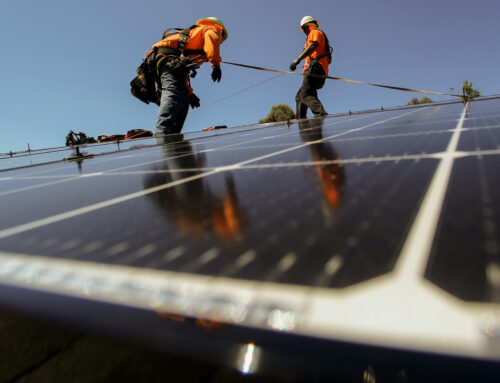Windows of Power: NEXT Technologies Produces Large-Scale Photovoltaic Windows
April 21, 2025
Glass, wood, concrete, and steel are the longtime cornerstones of building, but to keep up with 21st-century needs, NEXT Energy Technologies is transforming one of the architect’s basic tools — glass — into a source of renewable energy. The Goleta company’s pilot line of organic photovoltaic windows are the largest in the world, 40 inches x 60 inches, and generate clean, low-cost, renewable energy. And, as all windows should be, they are highly transparent.
Daniel Emmett, company cofounder and CEO, flicked a switch at the company’s laboratory, shining a burst of light on a small sheet of glass. As a slightly gray coating absorbed the light, the electricity produced caused a small spinner to whirl rapidly. Looking at the glass closely, the naked eye can see small veins printed on the glass. But they are discreet, not taking away from the aesthetic of the clean glass.
Unlike traditional solar panels, which are black in color and largely produced in China, the organic elements in NEXT’s coating allow the glass to be transparent. The materials used are earth-abundant, according to the company, low-cost and processed using a low-energy method. And the material can make any facade that uses glass become a source of solar-power generation, previously limited to rooftops, Emmett said, though he declined to be specific about the amount of power generated or the costs involved.
The company’s labs aren’t far from UC Santa Barbara, which generated Nobel Prize-winning research into organic semiconductors that underpins the NEXT techniques. Company founder Corey Hoven is among the university’s graduates in organic solar cells, while Emmett is a graduate of UC Santa Cruz. At the lab in Goleta, the coating is printed onto traditional architectural glass and also tested in simulations of a variety of weather conditions.
The company has been testing its product at Patagonia headquarters since 2022. Located in Ventura, Patagonia, an environmentally minded outdoor apparel company, has 22 power-generating windows, as well as solar panels over a parking lot. The two were successfully complementary, said Gin Ando, a Patagonia spokesperson. NEXT has been key lightening Patagonia’s solar footprint by collecting information over 530 days: they produced enough energy to charge 2,892 phones, according the partnership webpage with Patagonia.
The hardiness of the windows thus far looks to a future of net-zero buildings. NEXT predicts that the onsite renewable energy produced by its windows could offset 10-40 percent of a commercial building’s needs.
For the curious, NEXT will be offering a look at that future during an upcoming installation at its facilities later this year.
Search
RECENT PRESS RELEASES
Related Post














